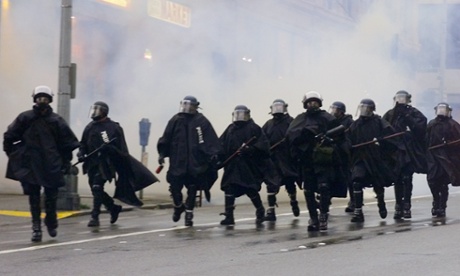Ferguson clampdown:
a brief history of curfews to contain protest in US cities
Used less frequently since the civil rights protests of the 1960s, the curfew remains a marker of serious unrest

On Saturday the governor of Missouri, Jay Nixon, issued a curfew for the city of Ferguson following days of clashes between police and residents protesting at the shooting of an unarmed teenager by a police officer. The curfew was due to run from midnight to 5am.
Turning to a curfew as a means of controlling civil unrest is not new. In fact, its history is rooted in the American civil rights movement.
In the late 1950s and early 1960s, African Americans filled the streets of Birmingham, Detroit, Philadelphia and Newark to demand equal rights, and cities increasingly responded with curfews, aggressively enforced by police. Prior to this, curfews were mostly a wartime phenomenon.
But civil liberties groups and many citizens fear curfews stifle free speech and the right of protestors to assembly.
“We criticize dictators for quelling dissent and silencing protesters with tactics like curfews; we’ll certainly speak out when it’s happening in our own backyard,” Steven Hawkins, the executive director of Amnesty International USA, said of the Ferguson curfew in a statement.
Although the citywide curfew has been used more often recently in response to natural disasters, it is still used on occasion as a way of controlling protests and civil unrests.
Los Angeles during the Rodney King riots
A dusk-to-dawn curfew was imposed in the city and county of Los Angeles during the 1992 riots that left more than 50 people dead and nearly 2,000 people injured. The riots erupted when four white officers with the LAPD were acquitted of severely beating a black man named Rodney King. The curfew lasted from 30 April to 4 May.
Cincinnati in 2001
Riots erupted in Cincinnati, Ohio, after a 19-year-old African American man was fatally shot by a city police officer in 2001. The streets raged for four days, with rioters vandalising buildings and looting local businesses. On the third day the mayor issued a citywide curfew that ran from 8pm to 6am. The curfew is largely credited with quelling the riots.
Occupy Protests in 2011
During the Occupy protests, some cities issued curfews on parks or specific areas where protestors camped, or beefed up enforcement of curfews already in place. State police arrested protestors in Albany for violating the 11pm curfew imposed shortly before their demonstration by New York governor Andrew Cuomo. In Chicago, Occupy protestors werehauled off by police for breaking a park curfew.
New Orleans during hurricane Katrina
New Orleans imposed a mandatory curfew after hurricane Katrina struck Louisiana. Law enforcement used the curfew as a way of regaining control of the battered city amid widespread looting and disorder. New Orleans also imposed dusk-to-dawn curfews after hurricane Gustav in 2008 and hurricane Isaac in 2012.
Seattle during the WTO protests
In 1999, a World Trade Organisation summit in Seattle, Washington, was met by a massive anti-globalisation demonstration. The protests drew thousands and triggered a heavy-handed and controversial crackdown by police. The mayor declared a state of emergency and imposed a strict 7pm to 7.30am curfew. The former Seattle police chief Norm Stamper, who was in charge of the police response, told the LA Times this week: “The biggest mistake in my 34 years of law enforcement was that we used a military response to a domestic situation.”
No comments:
Post a Comment